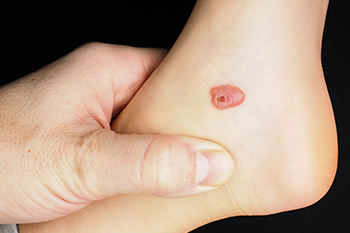Blisters are fluid-filled bubbles of skin that can appear on any part of the body and are particularly common on the feet. Most foot blisters form due to friction. As you walk, run, or go about your daily activities, your shoes may rub against specific areas of your feet, causing the skin to become damaged. The top layer of skin then separates from the lower layers of skin. The area between the separated layers fills with a fluid called serum, whose purpose is to cushion and protect the raw skin below the blister.
If you find a friction blister on your foot, it is highly recommended that you do not pop it. Popping the blister drains the fluid inside of it and exposes the raw skin underneath, increasing your risk of infection. Instead, protect the blister by loosely covering it with a bandage. You can also use special padding around the blister to protect it. Typically, friction blisters naturally heal over the course of one to two weeks. Friction blisters can be prevented by wearing well-fitted shoes and moisture-wicking socks. Wearing soft bandages over areas of your foot that tend to blister may also help.
Sometimes foot blisters can be caused by problems other than friction. Blisters can develop due to a sunburn, frostbite, or exposure to an allergen, as well as from medical conditions such as fungal infections or eczema. If you frequently find blisters on your feet, it is recommended that you consult with a podiatrist.






